MARKET OVERVIEW
The North America Impurities Testing market ensures the safety and quality of various products across industries. This market is dedicated to identifying and analyzing impurities present in different substances, ranging from pharmaceuticals to food and beverages. The demand for impurities testing has witnessed a significant surge due to the increasing emphasis on consumer safety and regulatory compliance.
In the pharmaceutical sector, the North America Impurities Testing market serves as a cornerstone for maintaining the integrity of medications. Rigorous testing protocols are implemented to detect impurities, such as residual solvents, heavy metals, and microbial contaminants, ensuring that pharmaceutical products meet the stringent regulatory standards set by authorities. This meticulous testing not only safeguards patient health but also upholds the reputation of pharmaceutical manufacturers.
Moreover, the food and beverage industry relies heavily on impurities testing to guarantee the purity and quality of consumables. With consumers becoming more conscious of what they consume, there is a growing demand for stringent testing procedures to identify contaminants like pesticides, additives, and allergens. The North America Impurities Testing market aids in establishing a robust framework for food safety, fostering consumer trust and satisfaction.
In the environmental sector, impurities testing plays a pivotal role in monitoring and controlling pollution levels. Laboratories dedicated to environmental testing utilize advanced techniques to detect impurities in air, water, and soil. This information is invaluable for regulatory bodies and policymakers, guiding them in formulating effective strategies for environmental protection and sustainable development.
The North America Impurities Testing market is characterized by constant innovation, driven by advancements in analytical technologies. State-of-the-art instruments, such as mass spectrometers and chromatographs, empower testing laboratories to achieve higher sensitivity and accuracy in impurity detection. This technological evolution enhances testing process efficiency and expands the scope of detectable impurities.
Furthermore, the market’s significance extends beyond regulatory compliance; it serves as a proactive measure for industries to identify potential issues before they escalate. Early detection of impurities allows for timely corrective actions, preventing costly recalls and mitigating reputational damage. This proactive approach is especially crucial in sectors where consumer trust is paramount.
The North America Impurities Testing market is a dynamic and indispensable component of various industries, ensuring the safety, quality, and compliance of products. As technological innovations continue to shape the landscape of impurities testing, the market remains at the forefront of safeguarding public health, environmental sustainability, and the overall integrity of diverse industries.
North America Impurities Testing market is estimated to reach $10,464.9 Million by 2031; growing at a CAGR of 8.1% from 2024 to 2031.
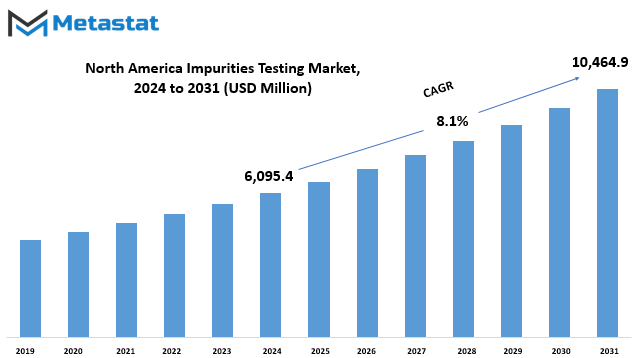
GROWTH FACTORS
The North America Impurities Testing market experiences growth due to various factors that play a pivotal role in shaping its trajectory. These growth factors contribute significantly to the market's upward momentum. On the flip side, certain challenges pose potential hindrances, casting shadows on this growth trajectory. Despite these obstacles, the market holds promise for lucrative opportunities in the foreseeable future.
One of the primary driving forces behind the growth of the North America Impurities Testing market lies in the factors that foster its expansion. These factors serve as catalysts, propelling the market forward and influencing its positive trajectory. Understanding and leveraging these growth factors are crucial for stakeholders aiming to navigate the dynamics of the impurities testing market successfully.
Conversely, the market faces obstacles that can impede its growth. Identifying and addressing these challenges is essential for stakeholders to effectively strategize and overcome potential hurdles. While these obstacles may create short-term setbacks, a comprehensive understanding of them allows for proactive measures to sustain and elevate the market's overall resilience.
Despite the challenges, the North America Impurities Testing market remains resilient and poised for growth. The dynamic nature of the market means that opportunities for expansion exist, waiting to be tapped. Recognizing and capitalizing on these opportunities can be instrumental in steering the market towards sustained growth.
The North America Impurities Testing market is shaped by a delicate balance of growth factors and challenges. Navigating this landscape requires a nuanced approach that acknowledges both the positive and negative aspects. As the market continues to evolve, stakeholders must stay attuned to these dynamics, adapting strategies to harness growth factors and overcome challenges effectively. The future holds promising opportunities for those who can navigate the complexities of the North America Impurities Testing market with a keen understanding of its intricacies.
MARKET SEGMENTATION
By Type
In the North America Impurities Testing market, the categorization by type delves into various facets to ensure a comprehensive assessment. The segmentation encompasses Identity Testing, Purity Testing, Heavy Metals Testing, Microbial Testing, and Others.
Identity Testing involves scrutinizing the components to confirm their authenticity. It ensures that the substances in question are indeed what they claim to be. This step is crucial in maintaining product integrity and preventing any misrepresentation.
Purity Testing, on the other hand, evaluates the degree of impurities present in a substance. It seeks to determine the extent to which a product meets the established purity standards. This is essential in guaranteeing the quality and safety of the tested materials.
Heavy Metals Testing focuses on identifying and quantifying the presence of heavy metals in a sample. Heavy metals can have detrimental effects on health, and assessing their levels is imperative, especially in products intended for consumption or topical application.
Microbial Testing addresses the potential microbial contamination in substances. It is pivotal in ensuring the safety of products, particularly those meant for human consumption or contact. Detecting and mitigating microbial impurities are essential steps to prevent health risks.
The category labeled as Others has a range of additional tests that may be specific to certain industries or products. These could include tests for specific chemical compounds, allergens, or any other parameters relevant to the context.
The North America Impurities Testing market, through its segmentation, employs a multifaceted approach to assess the quality and safety of various substances. Identity Testing confirms authenticity, Purity Testing evaluates impurity levels, Heavy Metals Testing identifies harmful metals, Microbial Testing addresses microbial contamination, and the category of Others encapsulates additional tests catering to specific needs. This comprehensive framework ensures a thorough examination of substances, contributing to the overall quality assurance in the market.
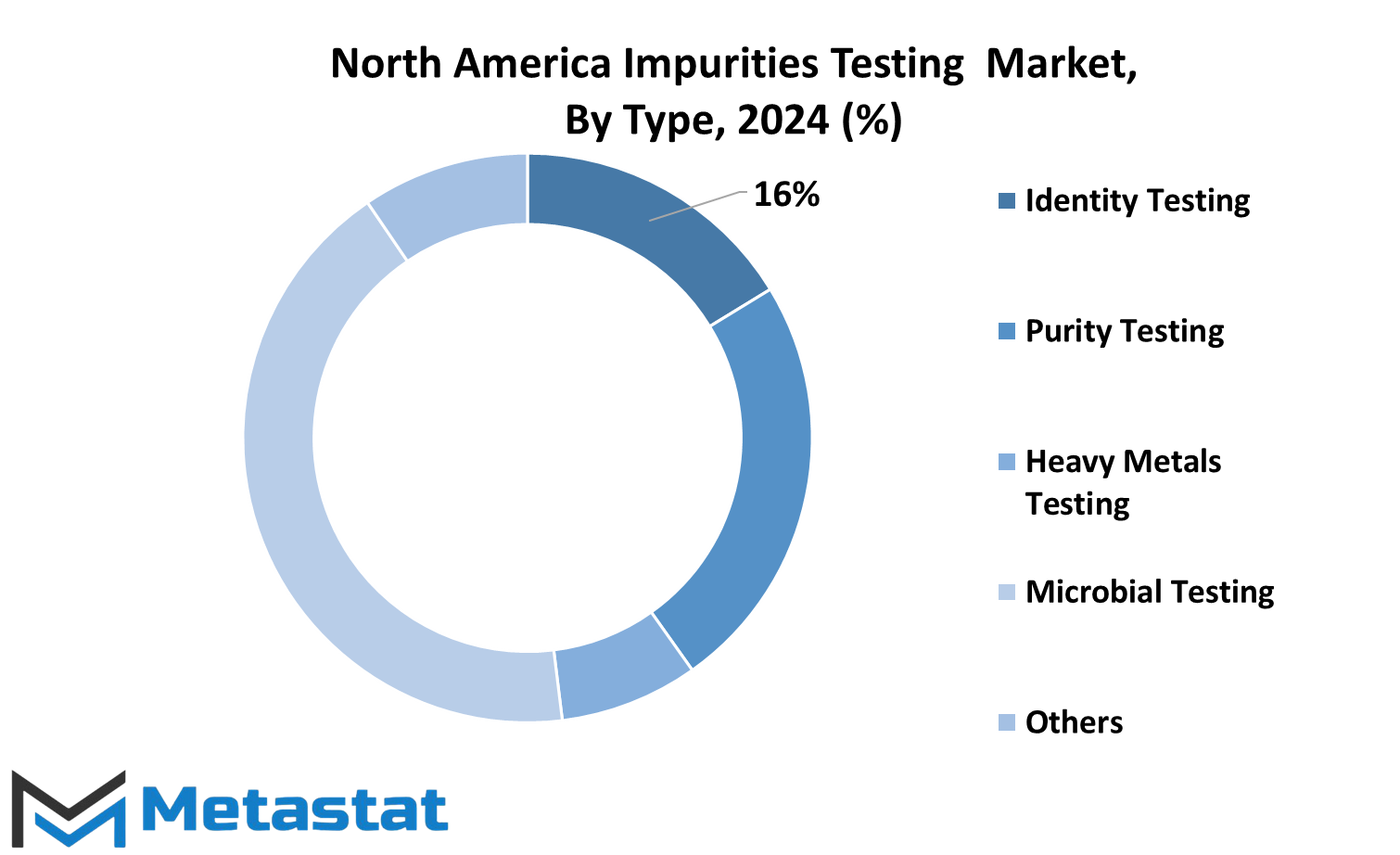
By Application
North America’s impurities testing market is segmented by application into three main categories: Dietary Supplement, Food, and Feed. Each segment plays a crucial role in ensuring the safety and quality of products consumed by the public.
Dietary supplements form a significant part of the market, reflecting the growing interest in health and wellness among consumers. The impurities testing in this sector is aimed at verifying the purity of supplements, ensuring they meet the necessary standards and do not contain harmful substances. This is especially crucial given the increasing popularity of dietary supplements in North America.
The Food segment represents another substantial portion of the impurities testing market. Food safety is a paramount concern for both consumers and regulatory authorities. Testing for impurities in food products helps identify and eliminate any potential hazards, ensuring that the food on our plates is safe for consumption. This aspect is vital in maintaining public health and trust in the food industry.
The Feed segment rounds out the applications of impurities testing in North America. With a focus on animal nutrition, this segment ensures that the feed provided to livestock is free from contaminants and meets quality standards. This is essential not only for the well-being of the animals but also for safeguarding the food supply chain by preventing the transfer of impurities from feed to food products.
The impurities testing market in North America serves a critical role in guaranteeing the safety and quality of products across the Dietary Supplement, Food, and Feed sectors. The emphasis on testing reflects the commitment to consumer safety and underscores the importance of maintaining high standards in the production and distribution of these essential goods. As consumers continue to prioritize health and well-being, the impurities testing market is poised to remain a key player in ensuring the integrity of the products we consume daily.
REGIONAL ANALYSIS
The North America Impurities Testing market is a dynamic sector that plays a crucial role in ensuring product safety and compliance. This market analysis focuses on North America, breaking it down into three major components: the United States, Canada, and Mexico.
In the United States, impurities testing is a vital process across various industries, helping to maintain high-quality standards for products available in the market. This testing ensures that consumer goods, pharmaceuticals, and other products meet regulatory requirements, providing a level of confidence to both businesses and consumers alike. With a robust regulatory framework, the U.S. emphasizes the importance of thorough impurities testing to safeguard public health and uphold product integrity.
Moving north to Canada, a similar emphasis on impurities testing is observed. The Canadian market, known for its diverse economy, places importance on maintaining quality control measures to meet global standards. Impurities testing in Canada is integral for sectors such as pharmaceuticals, food and beverages, and manufacturing, contributing to the overall safety and reliability of products distributed in the country.
In Mexico, impurities testing also holds significant importance. As a key player in the North American market, Mexico focuses on ensuring that products entering its markets comply with stringent quality standards. This is particularly critical in industries like pharmaceuticals, where the accurate testing of impurities is vital for meeting regulatory requirements and ensuring the safety of consumers.
The regional analysis of the North America Impurities Testing market underscores the shared commitment to quality and safety across the United States, Canada, and Mexico. While each country may have its unique regulatory nuances, the overarching goal remains consistent: to establish a robust framework for impurities testing that fosters consumer confidence and supports the integrity of diverse industries.
The North America Impurities Testing market reflects a collective dedication to upholding quality standards and ensuring the safety of products in the market. The regional analysis provides insights into the distinct approaches taken by the United States, Canada, and Mexico, demonstrating the shared commitment to stringent impurities testing practices in the region.
COMPETITIVE PLAYERS
In the North American Impurities Testing market, prominent players are making significant contributions. Among these key players are Intertek Group plc and Agilent Technologies. They play a vital role in the Impurities Testing industry, where ensuring the quality and purity of various products is paramount.
Intertek Group plc is one of the noteworthy entities in this sector. With a focus on providing quality assurance solutions, they contribute to maintaining the integrity of products. Their expertise spans across different industries, showcasing a commitment to upholding standards in Impurities Testing.
Another influential player in the North American market is Agilent Technologies. Specializing in analytical instrumentation and technologies, Agilent brings innovation to the Impurities Testing industry. Their contributions extend to enhancing the accuracy and efficiency of testing processes, ensuring reliable results for diverse applications.
The presence of these key players underscores the importance of Impurities Testing in North America. Their active involvement signifies a commitment to quality control and consumer safety. By leveraging their expertise, these companies contribute to maintaining the integrity of products circulating in the market.
The North American Impurities Testing market is enriched by the participation of key players like Intertek Group plc and Agilent Technologies. Their role in ensuring the quality and purity of products is pivotal, reflecting a dedication to upholding standards and contributing to the overall integrity of the industry.
North American Impurities Testing Market Key Segments:
By Type
- Identity Testing
- Purity Testing
- Heavy Metals Testing
- Microbial Testing
- Others
By Application
- Dietary Supplement
- Food and Feed
Key North America Impurities Testing Industry Players
- Intertek Group plc
- Agilent Technologies, Inc.
- Element Materials Technology
- Alkemist Labs
- LGC Limited
- UL LLC
- Thermo Fisher Scientific Inc.
- Bureau Veritas S.A.
- SGS SA
- PerkinElmer
- Eurofins Scientific
- ALS North America
- TÜV SÜD
WHAT REPORT PROVIDES
- Full in-depth analysis of the parent Industry
- Important changes in market and its dynamics
- Segmentation details of the market
- Former, on-going, and projected market analysis in terms of volume and value
- Assessment of niche industry developments
- Market share analysis
- Key strategies of major players
- Emerging segments and regional growth potential



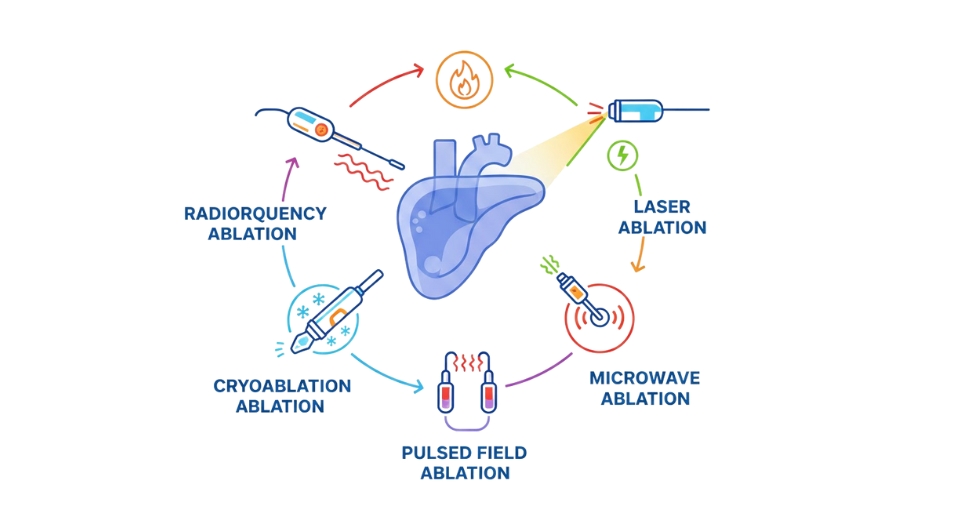

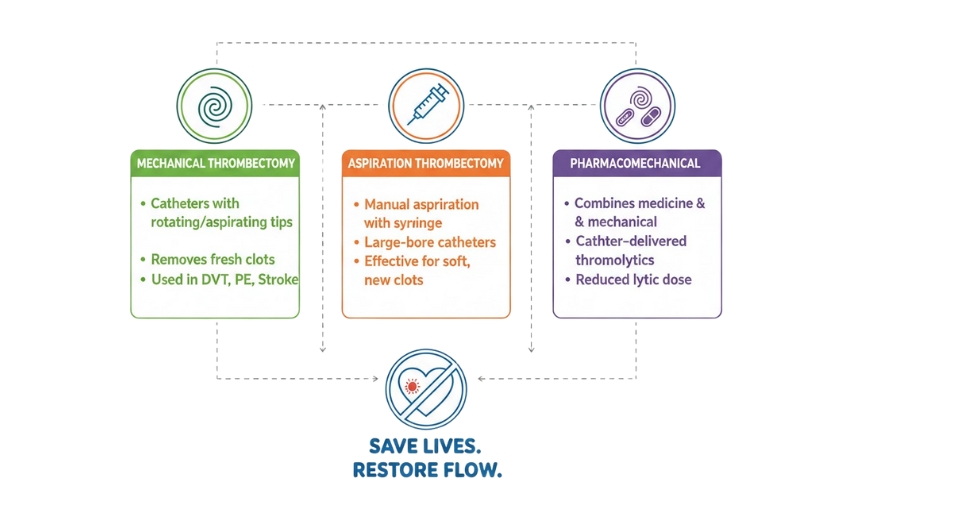
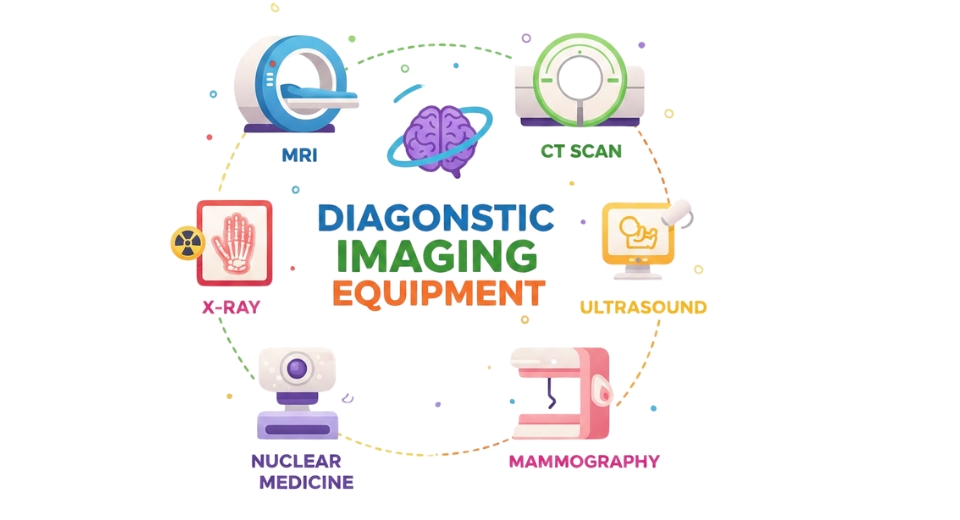

 US: +1 3023308252
US: +1 3023308252






